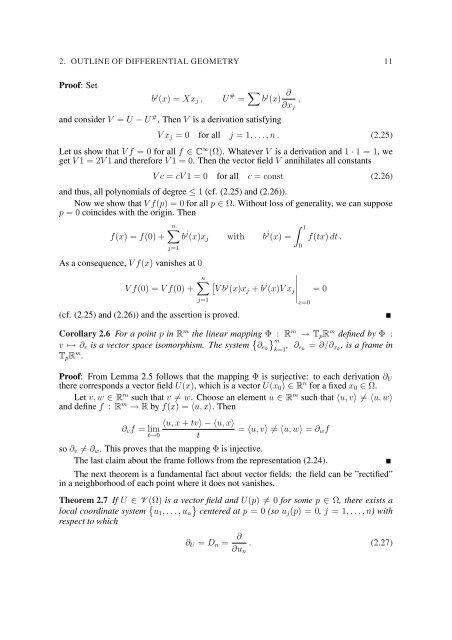EQUATIONS OF ELASTIC HYPERSURFACES
EQUATIONS OF ELASTIC HYPERSURFACES
EQUATIONS OF ELASTIC HYPERSURFACES
Create successful ePaper yourself
Turn your PDF publications into a flip-book with our unique Google optimized e-Paper software.
2. OUTLINE <strong>OF</strong> DIFFERENTIAL GEOMETRY 11<br />
Proof: Set<br />
b j (x) = Xx j ,<br />
U # = ∑ b j (x) ∂<br />
∂x j<br />
,<br />
and consider V = U − U # . Then V is a derivation satisfying<br />
V x j = 0 for all j = 1, . . . , n . (2.25)<br />
Let us show that V f = 0 for all f ∈ C ∞ (Ω). Whatever V is a derivation and 1 · 1 = 1, we<br />
get V 1 = 2V 1 and therefore V 1 = 0. Then the vector field V annihilates all constants<br />
V c = cV 1 = 0 for all c = const (2.26)<br />
and thus, all polynomials of degree ≤ 1 (cf. (2.25) and (2.26)).<br />
Now we show that V f(p) = 0 for all p ∈ Ω. Without loss of generality, we can suppose<br />
p = 0 coincides with the origin. Then<br />
n∑<br />
∫ 1<br />
f(x) = f(0) + b j (x)x j with b j (x) = f(tx) dt .<br />
j=1<br />
As a consequence, V f(x) vanishes at 0<br />
V f(0) = V f(0) +<br />
∣<br />
n∑ [ ∣∣∣∣<br />
V b j (x)x j + b j (x)V x j = 0<br />
x=0<br />
j=1<br />
(cf. (2.25) and (2.26)) and the assertion is proved.<br />
Corollary 2.6 For a point p in R m the linear mapping Φ : R m → T p R m defined by Φ :<br />
v ↦→ ∂ v is a vector space isomorphism. The system { } m<br />
∂ , ∂ ek k=1 e k<br />
= ∂/∂ xk , is a frame in<br />
T p R m .<br />
0<br />
Proof: From Lemma 2.5 follows that the mapping Φ is surjective: to each derivation ∂ U<br />
there corresponds a vector field U(x), which is a vector U(x 0 ) ∈ R n for a fixed x 0 ∈ Ω.<br />
Let v, w ∈ R m such that v ≠ w. Choose an element u ∈ R m such that 〈u, v〉 ̸= 〈u, w〉<br />
and define f : R m → R by f(x) = 〈u, x〉. Then<br />
∂ v f = lim<br />
t→0<br />
〈u, x + tv〉 − 〈u, x〉<br />
t<br />
= 〈u, v〉 ̸= 〈u, w〉 = ∂ w f<br />
so ∂ v ≠ ∂ w . This proves that the mapping Φ is injective.<br />
The last claim about the frame follows from the representation (2.24).<br />
The next theorem is a fundamental fact about vector fields: the field can be ”rectified”<br />
in a neighborhood of each point where it does not vanishes.<br />
Theorem 2.7 If U ∈ V (Ω) is a vector field and U(p) ≠ 0 for some p ∈ Ω, there exists a<br />
local coordinate system { u 1 , . . . , u n<br />
}<br />
centered at p = 0 (so uj (p) = 0, j = 1, . . . , n) with<br />
respect to which<br />
∂ U = D n =<br />
∂<br />
∂u n<br />
. (2.27)

















